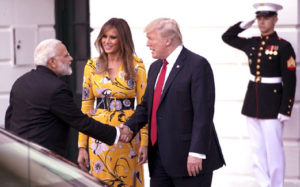Special to WorldTribune.com
UNITED NATIONS — India’s Prime Minister Narendra Modi returned to the USA not quite knowing what to expect from planned summit meetings with President Donald Trump.
After all while both leaders are known as brash and outspoken figures, the visitor from New Delhi was particularly nervous over trade deficits and immigration. Yet personal chemistry between the leaders of the world’s two largest democracies smoothed over earlier concerns.
The Indian/USA relationship has evolved immensely from the days when nonaligned but often Soviet-tilting India was one of those countries with which Washington managed its ties, rather than warmly embraced its relations. But following the collapse of the former Soviet Union, India had lost its chief geopolitical patron and feared isolation, especially facing neighboring China.

Starting in the Clinton Administration and especially into the Bush years, the United States and India revived social and economic ties. Following the terrorist attacks on America in 2001, the U.S. redoubled its defense cooperation with India, a country who knew all too well the enduring dangers of militant Islamist terrorism confronting its secular state.
In a Joint Communique, the leaders “stressed that terrorism is a global scourge that must be fought and terrorist safe havens rooted out in every part of the world.”
The USA and India reaffirmed their intelligence sharing, defense cooperation and counter -terrorism ties. Both states warned that Pakistan should not harbor terrorists which have been active in destabilizing Afghanistan as well as Kashmir.
Prime Minister Modi warmly intoned, “We consider the USA as our primary partner for India’s social and economic transformation in all our flagship programs and schemes.”
Economically too India’s democratic state socialism, copied from Britain, served as a deadweight to the entrepreneurial skills and business acumen of the Indian merchant classes. The old Nehruian “Hindu rate of growth” pegged at a static 2.2 percent has been discarded by successive Indians governments since the 1990’s who have looked to free markets and economic growth as the elixir of long overdue socio/economic change. Finally, a growing Middle class is beginning to offset the undertow of poverty.
Mr. Modi’s government has served as a proud booster of India as a global business partner. His trademark economic reforms are long overdue yet are still stymied by the maze of government red tape and bureaucracy.
GDP growth stands at an impressive 7 percent.
Business and trade between the two giant economies has boomed in the past decade. Back in 2006, two-way trade stood at $31 billion with a $12 billion deficit. Last year commerce reached $67 billion.
But growing foreign trade deficits have become a lightning rod for the American Administration; India’s $24 billion surplus with the USA is shadowed by China’s $347 billion in the same period.
Significantly, India is projected to become the world’s third-largest commercial aviation market by 2020. American aircraft sales to the South Asian giant are booming. In 2017, the Indian airline SpiceJet announced the order of 100 new Boeing 737’s, bringing its order to 205 planes valued at more than $20 billion and creating 130,000 American jobs in Washington state.
Defense cooperation is growing too as the U.S. is helping India’s military modernization program, especially for the Air Force. It’s no secret that the U.S. views India as a democratic counterweight to China’s strategic expansion.
The U.S. has worked with India to bring peace to conflict-ridden Afghanistan. Modi stated, “The increasing instability, due to terrorism, in Afghanistan is one of our common concerns. Both India and America have played an important role in rebuilding Afghanistan and ensuring its security.”
As a key member of the United Nations, India’s diplomacy holds genuine political clout among developing countries.
On the issue of immigration, what’s generally not known is that four million Indian-Americans live in the USA and over 700,000 U.S. citizens reside in India. For example, the U.S. Ambassador to the UN Nikki Haley is the daughter of Indian parents.
Writing in the Hindu newspaper, former Indian Ambassador Nirupama Rao noted, “In a well calibrated program, Prime Minister Modi’s U.S. visit reaffirmed an indispensable partnership.”
“The visible personal chemistry” was praised by Indian Foreign affairs officials. “This was one of the most productive of all prime ministerial visits to the United States,” added Foreign Secretary S. Jaishanlar, himself a former Ambassador to Washington.
A close relationship between India and the USA enhances global security and equally brings growing economic benefits to both partners. It’s a Win-Win for both Washington and New Delhi.
John J. Metzler is a United Nations correspondent covering diplomatic and defense issues. He is the author of Divided Dynamism the Diplomacy of Separated Nations: Germany, Korea, China (2014). [See pre-2011 Archives]

